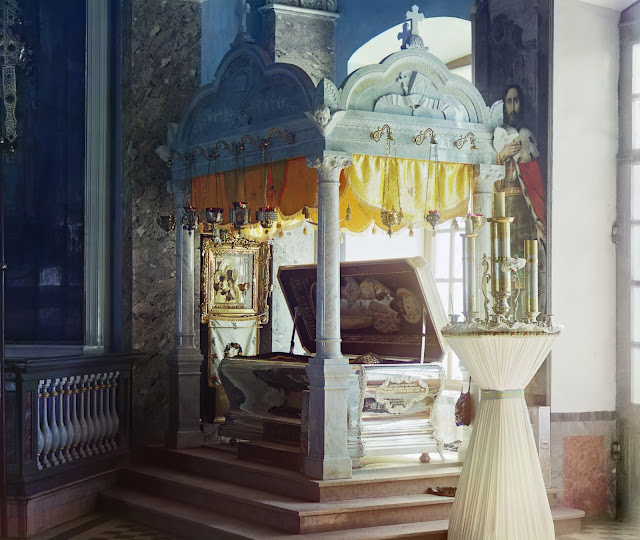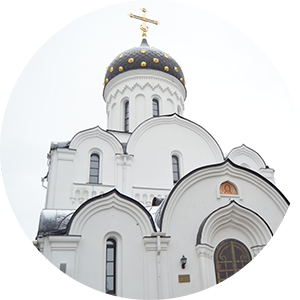St. Dimitriy
Tuptalo, Metropolitan of Rostov, was a Russian hierarch of the 17th century, a
remarkable preacher, and religious writer, professor of theology and ascetic,
but also miracle worker. Heis venerated today in the Russian Church but also in
the entire Orthodox space.
Childhood
St. Dimitriy was
born in 1651 in Makarovo, 40 km from Kiev, being baptized as Daniel. His
father, Sava Grigorjevich Tuptalo (†January 5, 1703) was a soldier and often he
was missing from home for a long time. Child's education was the particularly
concern of the mother, Maria Michajlovna (†March 29, 1689), who gave him a
Christian education. Soon the family moved to Kiev (1661), at that time located
in Poland, and at the age of 11 years, Daniel entered the Orthodox Academy of
Kiev (established by metropolitan Peter Movilă (Mogyla) some decades before),
whose leader was at that time Innokenty Gizela (c. 1600-1683), a brilliant preacher
and defender of Orthodoxy. Thanks to him, Daniel could develop during the study
(1665-1665) a great charisma to explain the Scriptures and became sensitive to
catechizing the faithful Church.
Monk
A few years later
(July 9, 1668, being 17) Daniel entered the Monastery of St. Cyril and received
the monastic tonsure, named Dimitriy, after St Demetrius of Thessalonica. In
addition to the usual ministries in monastery, which he performed with
obedience, the young monk managed to complete the studies and to begin his
missionary literary work.
 He was ordained a
priest on May 23, 1675 at Holy Trinity Monastery in Gustyn, Prykuly district,
and immediately was appointed by the Archbishop Lazar Baranov of Chernigov as
preacher. Further, during this period went on pilgrimage to see different holy
places in Belarus and Ukraine, at that time partly, in possession of the Greek
Catholics. He was appointed in the next years as minister in several cities, as
Chernigov (1675) and Slutsk (1677).
He was ordained a
priest on May 23, 1675 at Holy Trinity Monastery in Gustyn, Prykuly district,
and immediately was appointed by the Archbishop Lazar Baranov of Chernigov as
preacher. Further, during this period went on pilgrimage to see different holy
places in Belarus and Ukraine, at that time partly, in possession of the Greek
Catholics. He was appointed in the next years as minister in several cities, as
Chernigov (1675) and Slutsk (1677).
In 1678, after a
trip to Vilnius, he established in Baturyn, at the court of Hetman Ivan
Samoylovych. His sermons were typical for the Baroque period, consisting namely
in metaphors, allegories, rhetorical figures, questions and answers, especially
on moral topics.
Starting in 1680
the hieromonk Dimitriy lived mostly at Pecerska Lavra in Kiev, where he wrote
many sermons, especially against the local mores, especially alcoholism and
easier life. Soon it was given to him the leadership of several monasteries,
always against his will, because his only desire was to live in asceticism and
quietly. In this way he was abbot of Transfiguration Monastery of Maksakov,
Borsna district (1681), and the following year to the monastery of St. Nicholas
in Baturyn. Every time he tried to resign, but without succeed. His friends -
including St. Theodosius, Archbishop of Chernigov (celebrated on 5 February) -
managed to persuade him to remain abbot.
Writing the Lives
of the Saints and other works
This period of his
life was devoted to theological writings, being concentrated upon the ambitious
project of integrating all the lives of Russian saints into a single work,
which he published as The lives of the saints between 1684-1705. His resources
were the Greek Menologion of Saint Symeon Metaphrastes, the Menologies of
Metropolitan Makarij (1482-1563), the Collections of Vitae of the Bollandists,
the Annals of cardinal Baronius, and the Lives of the Saints of Piotr Skarga,
which means both orthodox and catholic sources. His compositions, which he never
pretended to be original, are until today very popular in the Slavic
space.
Together with his
popular writing about the saints, he wrote also a Research on the fake faith of
the schismatic (Rotsysk one cuz brynskoi raskolnitsei), a polemic work against
the Raskolniks (Old Believers), the Russians who didn’t accept the liturgical
reform of Patriarch Nikon form 1666. Dimitriy sees the error in the popular
inculture and not directly in their faith.
He
also wrote a Catechetic Compendium.
Also he found time
to study the ecclesiastical history of the Russian Orthodox Church, so he wrote
a Chronicle of the Lavra Pecerska, a Chronicle of the Russian tsars and
patriarchs, a Catalogue of the Russian
metropolitans, and also other works,
especially homilies.
For 25 years, Saint
Dimitriy devoted all the powers of such works, but besides the time spent to
these, he was praying in church or alone. He was living in the company of the
saints not only in writing but also in prayer, living their lives, suffering
their torments with them and studying the smallest details in all the documents
relating to them.
In return for his
love for the saints, God gave him often visions. On August 10, 1685, he saw in
a dream St. Great Martyr Barbara, notably honored by him. He asked her to
intercede for him before the Lord, but she admonished him because praying
"like the Roman Catholics", that means by meditating on the five
wounds of our Lord. Indeed, the influence of Roman Catholic theology and
spirituality was visible in the Russian Church in the cult. But after that St.
Barbara smiled and comforted him. On November 10, the same year, Saint Orest
appeared to him, the one of whom Dimitriy composed his life in the same day and
he said: "I suffered more torment for Christ than those you remembered."
Then he showed him a deep wound in the left side, saying: "Behold, this
was done by a red hot iron". Then he stretched out his right arm and
showed his veins that had been cut up to the elbow height and added:
"Here, these were cut" Then showed him similar injury to his left
arm, repeating the same words and then he showed that he had wounds on his
knees, saying: "These have been cut". After that, he stood right and
finally said, "You see, then, that I suffered more pain than you have
remembered" St. Dimitriy asked St. Orest if he was one of the five Saints
Martyrs whose feast is on December 13, but the martyr replied: "Not Orest
of the five Holy Martyrs Church, but he who is honored today and whose life you
just made it".
Metropolitan
In 1694 Dimitriy
was named abbot of the monastery of St. Peter and Paul in Hluchiv, in 1697 at
the monastery of St. Cyril in Kiev and in 1699 he was named Archimandrite at
the Transfiguration Monastery from Novhorod-Siverskyj. On March 23, 1701 Dimitriy was ordained a
bishop in Moscow, being appointed metropolitan for Siberia and Tobolsk. His
poor health and his need to have access to the texts necessary to continue the
writing of the saints’ lives, made him to ask to be moved elsewhere. He was
named in the Diocese of Rostov and Yaroslavl in January 4, 1702 and then he had
a vision, in which it was discovered to him that he will have to find the eternal rest there in
the monastery of St. James (Spaso-Yakovlevsky monastyr), in Rostov.
 During his life in
Russia, Dimitry opposed both the Old Believers' and Peter the Great's
ecclesiastical policies. He also made invaluable contributions to the Russian
education, opening a school and a small theatre in Rostov, where his own plays
could be staged.
During his life in
Russia, Dimitry opposed both the Old Believers' and Peter the Great's
ecclesiastical policies. He also made invaluable contributions to the Russian
education, opening a school and a small theatre in Rostov, where his own plays
could be staged.
Dimitry was also
active as a composer. Many of his Penitential Psalms achieved a wide
circulation, not only in the Ukraine but in the Balkans too, and many of them
have become an integral part of Ukrainian folk-song tradition through the
kobzari (itinerant blind singers).
Dimitry is credited
as composer or compiler of the first Russian opera of 6 hours, the Rostov
Mysteries (1705). It is an oratorio on the lives of Russian saints, based on
the "Cheti-Minei", published in four volumes in 1689, 1690, 1700 and
1705. The same source inspired Pushkin to write Boris Godunov in 1825.
Shortly before his
death, Saint Dimitriy completed his monumental work, the Lives of the saints
(in 1705), and further took only the care for his community. He tried very hard
to turn the religious life and manners of his contemporaries. Despite his
frequent illnesses, he continued a strict canon in his life and never left his
unceasing prayer. He also established a theological seminary near his home,
where he has assumed much of the teaching.
The burial
Saint Dimitriy has
foreseen his death three days before. He bowed to the ground and asked for
forgiveness from clergy and singers who served with him. After that, he closed
himself in his cell, in a fervent prayer. The next day morning, October 28,
1709, he was found dead, kneeling at prayer. Contrary to the saint's wishes,
which he expressed in his will, the clergy and people of Rostov asked the locum
tenens of the patriarchal throne, Metropolitan Stephen Yavorsky of Ryazan, who
had come for the funeral, to conduct the burial at the cathedral church of the
city.
Metropolitan
Stephen insisted on burying the body of his deceased friend beside St Joasaph,
who was St. Demetrius's predecessor. However, a grave was not prepared until
the arrival of Metropolitan Stephen, even although about a month had elapsed
since the saint's death.
Due to the urgent
departure of Metropolitan Stephen from Rostov, a hastily constructed wooden
frame was placed into the grave, in which the body of the saint was buried on
November 25. This circumstance, foreseen by the Providence of God, led to a
quick uncovering of the relics.
In 1752 repairs
were being done at the cathedral church of the Trinity in the monastery, and on
September 21, was discovered the incorrupt body of St Demetrius. The place of
burial had been affected by dampness, the oaken coffin and the writing on it
were decayed, but the body of the saint, and even the omophorion, sacchos,
mitre and silken prayer rope were preserved undamaged.
After the
uncovering of the holy relics many healings were worked, which were reported to
the Synod, by whose order Metropolitan Sylvester of Suzdal and Archimandrite
Gabriel of Simonov arrived at Rostov to examine the relics of St Demetrius, and
to investigate the incidents of miraculous healings.
Veneration
The Russian Church
proceeded with the official recognition in April 22, 1757. His celebrating day
is the day of his death, October 28, or November 10, according to the gregorian
calendar. Also another celebration is on September 21, the finding of his
miracle-working relics in 1752.
His relics are
until today in the cathedral church of St. Jacob monastery on Rostov. A
reliquary containing the right hand of St. Dimitriy is today in the St. Michael
Church from the village Polovki, Chernigov region.
Troparion (hymn) of the saint
„O, lover of
Orthodoxy and uprooter of schism, healer of Russia and new advocate before God,
by thy writings thou didst heal the minds of the foolish. O blessed Dimitriy,
thou harp of the Spirit, entreat Christ God, that our souls may be saved!”



















CONVERSATION